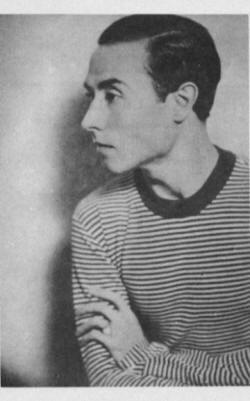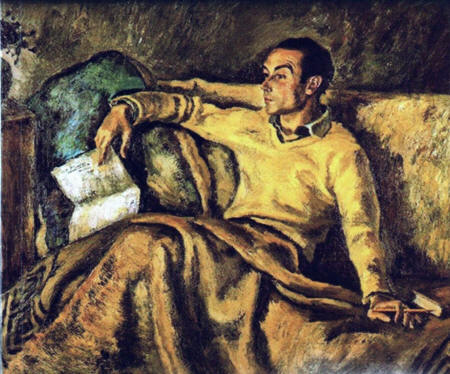

 Juan Gil-Albert Simón (April 1, 1906 –July 4, 1994) was a Spanish poet and essayist.
Román Gubern writes about the gay group which surrounded Salvador Dalí and
Federico García
Lorca (among them,
Luis Cernuda, Benjamín Palencia,
Juan Gil-Albert,
Vicente
Aleixandre, Gustavo Durán and
Eduardo Blanco Amor) men who were “compañeros
de [la] constelación cultural de García Lorca”.
Juan Gil-Albert Simón (April 1, 1906 –July 4, 1994) was a Spanish poet and essayist.
Román Gubern writes about the gay group which surrounded Salvador Dalí and
Federico García
Lorca (among them,
Luis Cernuda, Benjamín Palencia,
Juan Gil-Albert,
Vicente
Aleixandre, Gustavo Durán and
Eduardo Blanco Amor) men who were “compañeros
de [la] constelación cultural de García Lorca”.
Juan Gil-Albert is the author of Heraclés: about a way of being, written in 1975 on the status of homosexual. Ideal image of the Greek man, Hercules marries, loves women, and, logically, also has love affairs with young men. Heracles loved Hylas, his young cousin, and maintained a passionate love with him until the young man left him to follow the love of women. Heracles has known the defeat of loving abandonment. If every hero embodies hypermasculinity, Hercules is at the extreme. By embracing this myth to think about homosexuality, Gil-Albert is rejecting the effeminacy that often accompanies homosexual culture (from its iconography to its languages), and in which some sectors of gay culture so often indulge. Instead, Gil-Albert's theory of male homosexuality leads to a theory of masculinity. It is an unavoidable implication, typical of those who move to a theoretical extreme (at the other extreme, the feminist movement has never been ashamed of the fact that those who love it very often think about the feminine condition).
From a family belonging to the high bourgeoisie, his first years of training were run by a private teacher and at a school of nuns in Alcoy. When he was nine years old, the family moved to Valencia after his father, who opened a hardware store there, and entered the Colegio de los Escolapios as an intern. In Valencia he finished high school and began his studies in Law and Philosophy and Letters, without finishing these careers, which bore him. He reads a lot, but the authors who mark him are especially Gabriel Miró, Valle-Inclán and Azorín. In 1927 he published his first two prose works, The Fascination of the Unreal, a collection of stories costed by himself and with influences by Oscar Wilde and Gabriel Miró, and Vibration of the Summer. Critics welcomed these works enthusiastically, especially The Provinces of Valencia and El Noticiero Regional de Alcoy. From 1929 he entered politics with José Bueno, Juan Miguel Romá and Juan Renau. Max Aub put him in touch with all the "ismos" and avant-gardes. And Federico García Lorca, Juan Ramón Jiménez, Luis Cernuda, Manuel Altolaguirre, Pablo Neruda, María Zambrano, Rosa Chacel, Miguel Hernández and Vicente Aleixandre between 1930 and 1934 put him in touch with poetry.


Juan Gil-Albert, Antonio Sánchez Barbudo y Ramón Gaya en Valencia, 1935
In the period 1936-1938, Manuel Altolaguirre published his first poetic books, quite late; the first appeared in 1936 with the title Mysterious Presence, a collection of love-themed sonnets where the imprint of Luis de Góngora and Stéphane Mallarmé is felt, followed by Candent horror, of the same year. From 1938 it is ignored names, printed in Barcelona and which implies his sore awareness of the Spanish Civil War. In 1936 he co-founded in Valencia the magazine Hora de España, whose writing consists of Juan Gil-Albert, Rafael Dieste, Antonio Sánchez Barbudo and Ramón Gaya. In mid-1937, they joined them in the writing María Zambrano and Arturo Serrano Plaja. When Valencia becomes the capital of the Republic, the house of Juan Gil-Albert becomes a meeting place for Republican intellectuals. He participates in the organization of the II International Congress of Writers forthe Defense of Culture, as well as, in the drafting of the famous Collective Presentation. In Memorabilia Gil-Albert has evoked his encounters of those days with Louis Aragon, Octavio Paz, along with the memory of other names, such as Antonio Machado, Alberti, Miguel Hernández, José Bergamín.... After the war goes to a refugee camp in France. He went into exile from 1939 to 1947 to Mexico and Argentina. In Mexico he is secretary of the magazine Taller directed by Octavio Paz and makes film critics in Romance magazine. He also collaborates in Letras de México and El hijo Prodigo,with poems and prose. In late 1942 he traveled to Buenos Aires and collaborated in the Argentine newspapers Sur and on the literary page of La Nación. There he met Jorge Luis Borges and published El convaleciente (1944). He returned to Valencia in 1947, living an interior exile outside the dominant currents. For this reason some critics consider him an unhooked and isolated member of the Generation of 27,although the date of publication of his first poetic work (1936) has made others consider him part of the Generation of 36 or, at least, as a nexus between the two generations. After his return to Spain he published El existir meditates on his current(1949), Concertar es amor (1951) and joins in an inactive silence. His lack of contact with the social and cultural media of Francoism is absolute and lives immersed in years of feverish and intense writing until in 1972 the collection "Ocnos" publishes Fuentes de la constancia,poetic anthology that rescues him for criticism and in 1974 General Chronicle,which popularizes him among the general public. They will follow Meta-Physics (1974), Revolt table,(1974), a re-editing of The Illusions (1974). In Heraklés: on a way of being (1975), he addresses the issue of homosexuality inspired by André Gide's Coundron. They follow Memorabilia (1975), Tributes and Impromptus (1976), To the Presocratics (1976), The Idle and the Professions (1979), Breviarium vitae (reissued in 1979), etc. The definitive consecration would come to him in 1982 with the Prize of Letters of the Valencian Country. He then received the Medal of Merit of Fine Arts,was an Honorary Doctorate from the University of Alicante and a favorite son of Alcoy. His complete prose work was published in 1985. Juan Gil-Albert, avant-garde and surreal in his beginnings and possessing a great and careful style, is subsequently more committed to the reality of his time following his experience during the Spanish Civil War and exile. Always true to himself and unsobable, rebellious at times, of broad Greco-Latin cultural references and an epicurean and extreme sensitivity to beauty, he moves between storytelling and evocation, reflection and criticism. Perhaps that is why his prose work is one of the most memorable of the twentieth century and as a poet he powerfully influenced the lyrics of the 1970s, starting mainly from his hatching of 1974. It was in that year that he published his autobiography in prose, Chronicle General (1974), as well as, in later years, the autobiographical Heraklés (1975) and Breviarium Vitae (1979).
My published books: